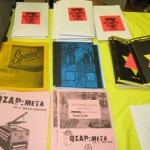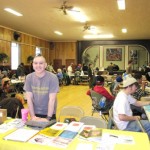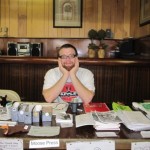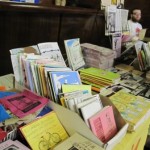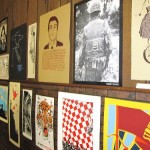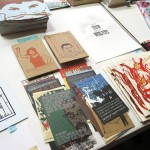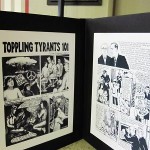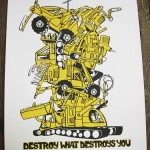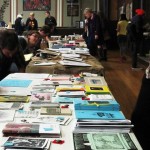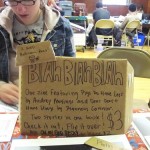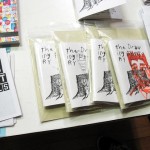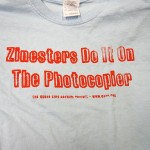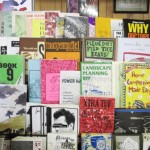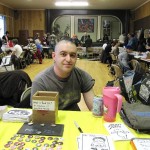Photo Gallery from the 2009 Milwaukee Zine Fest
Photos by Erin Petersen
Riverwest’s Falcon Bowl welcomed swarms of zine makers and enthusiasts last Saturday afternoon for the 2009 Milwaukee Zine Fest. Each table was jam-packed with loads of original, handcrafted publications, prints and neatly bound anthologies. Distros from Portland, Chicago and Milwaukee abounded with comics and zines about everything under the sun — from do-it-yourself household manuals (now I know how to make my own deodorant!) to feminist theory and radical politics and art. I found myself rounding the room several times, cooing over a few prints from Just Seeds and ultimately leaving with hands full and pockets happily empty.
This year’s fest was spearheaded by Miss Nico and the Queer Zine Archive Project (QZAP), a Milwaukee-based digital zine archive that focuses specifically on the expansion and preservation of queer culture in print. QZAP was created in 2003. A labor of love for founders Milo Miller and Chris Wilde, QZAP has grown tremendously over the past six years with nearly 300 documents online and 1,200 publications in their collection. I used to intern for QZAP back in the day — which meant that I got to look through dozens of zines while I was loading them to the web, and I got school credit for it. It was amazing.
I caught up with Milo before the fest to chat about QZAP, the fest and the evolution of the indie press in Milwaukee.
MM: Well, it was our sixth anniversary last week. In celebration, I posted a bastardized version of A.A. Milne’s Now We Are Six on QZAP [laughs]; I even Photoshopped in a blue mohawk for Christopher Robin. We also launched our new website in September. Other than that, we’ve just been working on getting the zine fest together and continuing to put new zines up on the website. We actually just received some in the mail from Australia this week.
TCD: How did you get into making — and now collecting — zines?
: I started reading zines a long time ago because I was the loneliest queer punk in Milwaukee, or at least I thought I was. I started making them myself, and now as an archivist, I feel like a sort of protector. It’s funny, it makes me feel like an art curator, doing something very swanky when we’re actually talking about dirty punk-rock publishing.
TCD: What is it about the zine medium that was so attractive to you?
MM: It’s a lot of things really. On the one hand, zines are these amazing artifacts. They’re tangible objects — when someone hands you something with a hand-stitched binding, or even a zine that they made by scamming the photocopier at work while no one was looking — you really appreciate the effort put into the object. They also offer the ability to get people’s voices out there in a way that’s not done in the mainstream media or online even. When you work on line-blogging, for instance, unless you own the server, someone else owns the infrastructure. With zines, you own the infrastructure.
TCD: I’m curious about your thoughts on the future of zines. Is the medium built to last?
MM: I think there’s the possibility of a quasi-renaissance in the zine community right now. We’re (QZAP) constantly seeing new zines, plus the emergence of sites like ZineWiki, ZineLibrary and We Make Zines. The community is a lot more broad. At this point, the future of print and broadcast media is uncertain, but that has no effect on zines. The practice of self-publishing was grown out of opposition to traditional media and will continue to grow and thrive in spite of it. You can trace the emergence of zines back as far as the founding fathers when you think about it. I mean, the guy was kind of creepy … but Ben Franklin was a zinester.
- A table at the 2009 Milwaukee Zine Fest. Photos by Erin Petersen.
- A t-shirt from the QZAP table.
- Microcosm Publishing
- Milo Miller of QZAP




